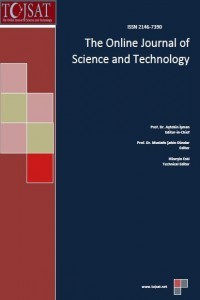BIODEGRADATION OF PESTICIDE: BROMUCONAZOL BY MICROBIAL CONSORTIUM IN BIPHASIC SYSTEM
BIODEGRADATION OF PESTICIDE: BROMUCONAZOL BY MICROBIAL CONSORTIUM IN BIPHASIC SYSTEM
fungicide, Biodegradation, Bromuconazol biphasic system, Batchs, microbial Consortium. Aeromonas hydrophila,
___
- Bollag, J.M. (1982). Microbial metabolism of pesticides in Rosazza. JP (Ed), Microbial transformation of bioactive compounds. Inc. Bocca Rton ( pp.126 – 18). CRC. Press.
- Bouziani, M. (2007). L’usage immodéré des pesticides. De graves conséquences sanitaires. Le guide de la médecine et de la santé. Santémaghreb.
- Calderbank, A. (1989). The occurrence and significance of bound pesticide residues in soil. Reviews of environnemental contamination and toxicology, 108, 71 – 103.
- Cluzeau, S. 1996. Index phytosanitaire. 32ème édition. Paris : A.C.T.A. p. 283. EPA. (1999). Agence de la protection de l’environnement des Etats Unies. 735-R-98-003, 1999.
- Muller,W.F., Scheunert, J., Kozman, K. & Kögel, W. (1978). Comparative metabolism of hexachlorobenzene and pentachloronitrobenzene in plants, rats and rhesus monkeys. Ecotox. Environ. Saf, 2, 437 – 445.
- Rosenberg, M. (1984). Bacterial adherence to hydrocarbon: a useful technique for studding cell surface hydrophobicity. FEMS Microbiol. Lett, 22, 289-295.
- Senesi, N. (1993). Organic pollutant migration in soils as affected by soil organic matter: Molecular and mechanistic aspects. Aatoasi series, 32, 47 – 74.
- ISSN: 2146-7390
- Başlangıç: 2011
- Yayıncı: The association of science, education and technology
A CFD MODEL FOR SIMULATING URBAN FLOW IN COMPLEX MORPHOLOGICAL STREET NETWORK
Saddok Houda, Noureddine Zemmouri, Abdelmalek Hasseine, Rachid Athmani, Rafik Belarbi
Adnan Aldemir, Suna Ertunç, Hale Hapoğlu, Mustafa Alpbaz
Houria Ouled-Haddar, Tayeb Idoui, Mohamed Sifour, Messaouda Guezira, Messaouda Bouthabet
Oluwole Abimbola, Tyler Bowling, Bahadir Edizer, Heather Kunze, John Thistlethwaite
WATER EFFECT ON DETERIORATIONS OF ASPHALT PAVEMENTS
SMALL ROV TO DETECTION AND IDENTIFICATION OF DANGEROUS UNDERWATER OBJECTS
Jerzy Garus, Agnieszka Studanska
CHEMICAL MODIFICATION OF WATER HYACINTH FOR THE REMOVAL OF DYESTUFFS
Winai Somboon, Vanida Bhavakul, Suntud Sirianuntapiboon
Suree Nanasombat, Kanittha Khanha, Jiraporn Phan-im, Jutatip Jitaied, Saranya Wannasomboon, Sarissa Patradisakorn, Anusa Wongsil
Mohamed Sifour, Idoui Tayeb, Houria Ouled Haddar, Heba Namous, Salima Aissaoui
BIODEGRADATION OF PESTICIDE: BROMUCONAZOL BY MICROBIAL CONSORTIUM IN BIPHASIC SYSTEM
